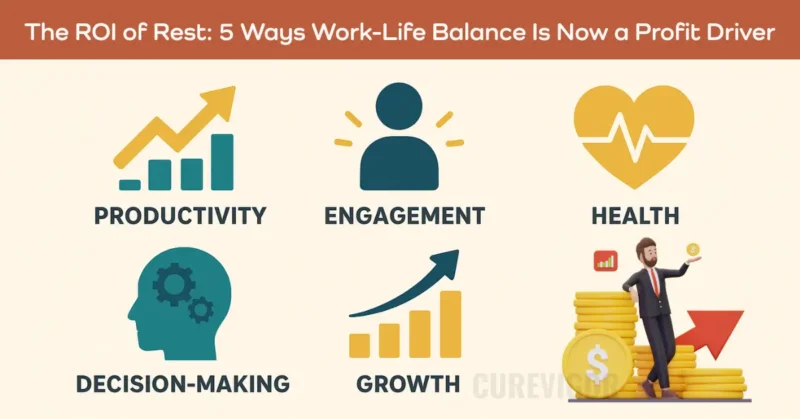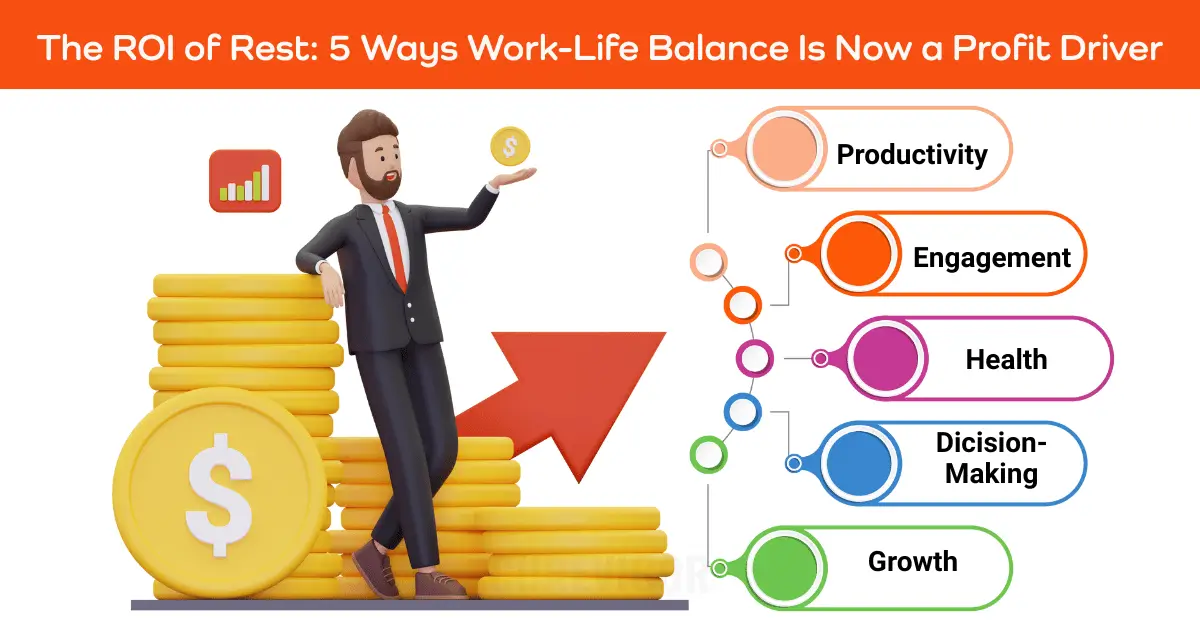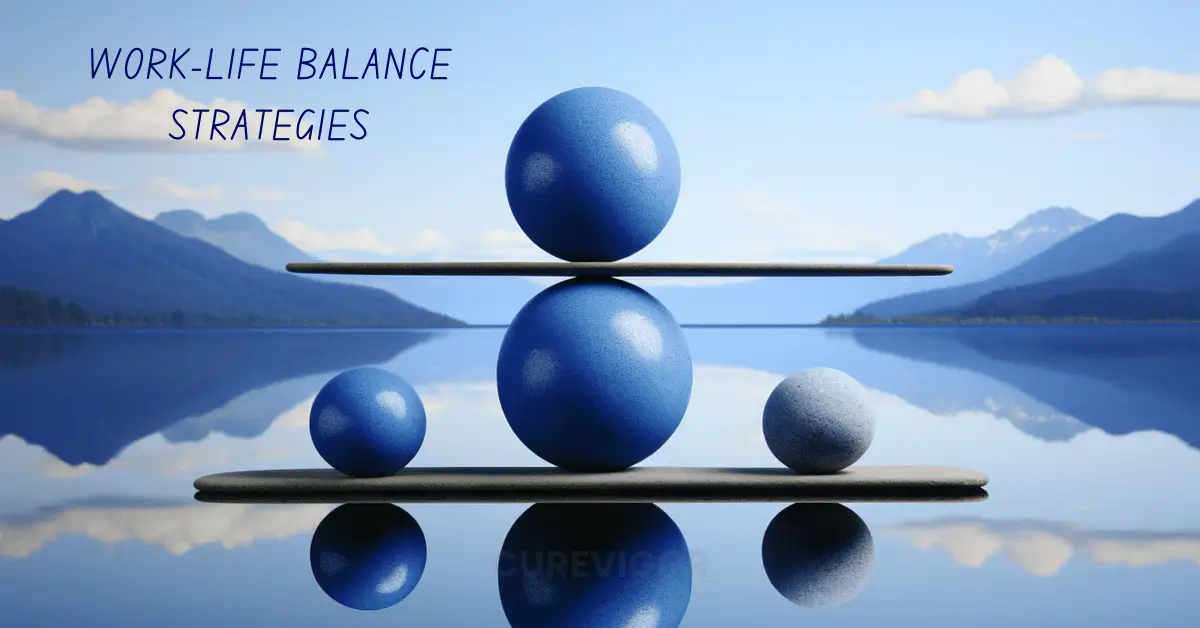Find out how work–life balance drives profit, innovation, and retention in today’s economy. Learn 5 proven ways rest fuels productivity and business growth.
Thank you for reading this post, don't forget to subscribe!Introduction: The New Business Imperative
In 2023, 45% of U.S. workers reported feeling burned out weekly (Gallup). As workplace stress reaches unprecedented levels in today’s economy, companies are realizing a critical truth—rest isn’t a perk; it’s a profit driver.
Organizations that invest in work–life balance are seeing tangible business gains, including:
- 21% higher productivity and innovation
- 50% lower turnover and recruitment costs
- 30% fewer sick days and healthcare expenses
- Improved decision-making and risk management
- Stronger talent attraction and competitive advantage
In short, the ROI of rest is transforming modern business success.
In this article, you’ll discover how work–life balance delivers measurable returns—fueling happier teams, smarter leadership, and sustainable growth in today’s economy.
The ROI of Rest: Understanding the Connection Between Balance and Business Performance
Work-life balance isn’t just about happiness—it’s about sustainable success. When employees rest, they return to work sharper, healthier, and more innovative. Let’s break down the 5 key ways balance drives profit.
The ROI of Rest refers to the tangible and intangible benefits—financial, operational, and cultural—that organizations gain when employees are given adequate time and space to recover.

When teams are rested, they perform at a higher cognitive level. They make fewer errors, collaborate better, and approach problems creatively.
In contrast, overworked employees may deliver short-term results, but long-term fatigue leads to poor decisions, health issues, and high turnover—each of which comes with a financial cost.
Increased Productivity and Efficiency
Adequate rest sharpens focus and attention span. A study by the World Health Organization found that employees working more than 55 hours a week face a 35% higher risk of stroke, while output per hour actually drops.
In today’s economy, smarter scheduling and consistent breaks help workers sustain energy, perform complex tasks better, and stay engaged longer.
Improved Employee Retention
When employees feel supported and balanced, they stay longer. Work–life balance programs reduce burnout, foster loyalty, and build trust between teams and leadership.
Companies like Microsoft Japan, which implemented a four-day workweek, reported 40% higher productivity and improved retention.
From Burnout to Breakthrough: The True ROI of Rest
For years, burnout was seen as an unavoidable side effect of ambition. But in today’s economy, the smartest companies are rewriting that story. They’re discovering that rest, recovery, and balance aren’t signs of slowing down—they’re the keys to speeding up sustainable success.

When teams are energized and minds are clear, innovation thrives, productivity soars, and profits follow naturally. That’s why more leaders are beginning to see balance not as a cost, but as an investment that delivers measurable returns.
Let’s explore the five powerful ways the ROI of rest is redefining success in today’s economy.
1. The ROI of Rest: Boosting Productivity and Innovation
Rest fuels creativity. When minds are relaxed, they make unexpected connections.
Rest isn’t time wasted—it’s time invested. Sleep, breaks, and downtime allow the brain to consolidate information and reset.
Data-Driven Impact:
- Employees with better work-life balance are 12% more productive (Stanford).
- Companies with balanced cultures see 30% fewer sick days (American Psychological Association).
- Teams with balanced workloads produce 20% more innovative ideas (Forbes).
- Google’s “20% time” policy (unstructured time for passion projects) birthed Gmail and AdSense.
Actionable Tip:
“Schedule ‘deep work’ blocks for focused tasks, then protect 15-minute breaks to recharge. Use tools like Time-Blocking Templates to structure your day.”
Why Rest Fuels Breakthrough Thinking
Your brain’s default mode network activates during rest, sparking creative connections and innovative solutions. Companies that prioritize balance see:
- 67% higher innovation scores (Harvard Business Review)
- 45% more likely to improve market share year-over-year
- 3.5x more likely to be creative leaders in their industry
Real-World Example: Microsoft Japan’s “Work-Life Choice Challenge” implemented 4-day workweeks, resulting in 40% productivity gains and 23% lower electricity costs.
Action Step: Implement “Focus Fridays” with no internal meetings to protect deep work time.
The Productivity Multiplier
Overworking leads to diminishing returns—what starts as productivity ends in burnout. Studies show that after 50 hours per week, performance per hour declines sharply.
Rest, however, rejuvenates the brain, improving problem-solving, focus, and time efficiency.
The Innovation Advantage
Downtime fuels creativity. Rested employees access deeper parts of the brain’s “default mode network,” responsible for insights and innovation.
Think about how Google’s “20% Time” policy led to groundbreaking products like Gmail and AdSense. When employees are given time to rest and think freely, creativity blossoms—and so does company revenue.
Real-World Example
When Microsoft Japan tested a shorter workweek, output soared by 40%. Employees used fewer resources, made fewer mistakes, and reported higher morale. The message was clear: when rest increases, productivity multiplies.
2. The ROI of Rest: Enhancing Engagement and Retention
Turning Balance into Loyalty
Turnover is expensive. Replacing an employee costs 1.5–2x their salary (SHRM). Work-life balance is a top reason employees stay.
Data-Driven Impact:
- 50% lower turnover in companies with strong balance initiatives (Harvard Business Review).
- 41% lower absenteeism
- 2.3x higher employee satisfaction scores
- 80% of job seekers prioritize work-life balance over salary (Glassdoor).
Case Study: Patagonia’s family-friendly policies resulted in 100% retention of mothers returning from maternity leave, saving millions in recruitment costs.
Action Step: Create a “Flexibility Menu” allowing employees to choose work arrangements that fit their lives.
“Offer flexible hours or remote options. Even small gestures—like ‘no-meeting Fridays’—build loyalty.”

Engagement Through Balance
Employee engagement directly correlates with profit. According to Gallup, companies with engaged employees experience 21% higher profitability.
Rest plays a central role here. A balanced schedule enhances focus and motivation, while burnout drains creativity and commitment.
Reducing Turnover Costs
It can cost up to twice an employee’s yearly compensation to replace them. Burnout and stress are leading causes of resignation, especially in hybrid work environments.
Work–life balance initiatives—such as flexible schedules, mental health days, and wellness programs—help retain top talent and foster long-term loyalty.
Motivation and Morale
When employees feel their time is valued, they reciprocate with dedication. Recognition, autonomy, and rest create a culture where people want to contribute, not have to.
In today’s economy, this emotional connection between balance and belonging is a major driver of profits.
3. The ROI of Rest: Reducing Healthcare Costs
Preventing Burnout Before It Hits Your Bottom Line
Burnout leads to chronic stress, which drives up healthcare spending.
Chronic workplace stress costs U.S. businesses $300 billion annually in healthcare and lost productivity. Balance-focused companies see:
- 30% fewer health claims
- 50% lower risk of cardiovascular disease among employees
- $6 saved for every $1 invested in wellness programs
- Companies with high burnout rates spend $190 per employee per day on healthcare (Harvard Medical School).
- Work-life balance programs can reduce stress-related absenteeism by 30% (APA).
Data Point: Aetna’s mindfulness program resulted in $3,000 in annual healthcare savings per employee and 62 minutes of weekly productivity gains.
Action Step: Implement mandatory vacation policies and “right to disconnect” guidelines.
The Cost of Overwork
Burnout doesn’t just affect morale—it drains company finances. The American Psychological Association estimates that workplace stress costs U.S. businesses over $500 billion annually, including absenteeism and health issues.
Healthier Workforce = Lower Costs
Adequate rest improves immune function, reduces heart disease risk, and lowers mental health claims. When employees recharge properly, they’re less likely to fall ill or need extended leave.
This directly translates into lower insurance costs, fewer sick days, and consistent productivity.
Preventing Burnout Before It Starts
Companies that integrate recovery into their culture—through “no meeting Fridays,” mindful breaks, or mental wellness programs—build resilience and reduce healthcare spending.
In a high-pressure market, that’s not just humane leadership—it’s smart economics.
4. The ROI of Rest: The Decision-Making Dividend
A rested workforce attracts talent, improves decision-making, and fuels growth.
Data-Driven Impact:
- Companies with balanced cultures grow 3x faster (Gallup).
- Rested employees make 15% fewer errors in decision-making (McKinsey).
How Rest Sharpens Executive Function
Sleep-deprived leaders make 20% riskier decisions and show reduced emotional intelligence. Companies prioritizing rest report:
- 26% better year-over-year performance (McKinsey)
- 42% faster decision-making cycles
- 37% higher sales from well-rested teams
Real Impact: When NASA implemented fatigue management, error rates dropped by 50% and productivity increased by 13.5%.
Action Step: Institute “meeting-free zones” during peak energy hours for strategic thinking.
Better Rest = Better Decisions
Fatigue undermines judgment. Research from Harvard Business Review shows that sleep-deprived leaders are 20–30% more likely to make poor decisions.
When leaders rest, they process complex information more effectively and respond with clarity rather than reaction.
Emotional Intelligence and Stability
Well-rested individuals demonstrate greater patience, empathy, and emotional regulation. These soft skills translate directly into stronger leadership and team cohesion.
The Ripple Effect of Balanced Leadership
Leaders who model rest empower their teams to do the same. A culture of sustainable performance begins at the top—and results in fewer errors, smoother collaboration, and higher overall morale.
In today’s economy, leadership isn’t about endurance—it’s about energy management.
5. The ROI of Rest: Driving Business Growth
Attracting Top Talent in the New Economy
83% of workers say work-life balance is more important than salary. Companies with strong balance cultures experience:
- 3.8x more likely to inspire organizational commitment
- 2.1x higher customer satisfaction scores
- 4x higher revenue growth compared to industry peers
Success Story: Unilever’s flexible work program led to 12% higher employee engagement and $2 billion in savings from reduced office space.
Action Step: Develop a “Results-Only Work Environment” (ROWE) that focuses on outcomes rather than hours.
Talent Attraction and Employer Brand
Modern professionals seek workplaces that value balance. High-performing talent is drawn to companies that provide wellness initiatives, flexible scheduling, and mental health support.
In today’s economy, where skilled labor is scarce, a culture that promotes rest becomes a competitive differentiator.
Growth Through Innovation and Trust
Balanced teams generate more innovative solutions and make smarter business decisions.
Companies like Salesforce and Patagonia show that cultures rooted in well-being don’t just retain talent—they expand market share and brand loyalty.
The Profit Connection
Every hour of rest amplifies output quality. Healthy, motivated employees produce better results, innovate more, and contribute to long-term growth.
Work–life balance isn’t a perk anymore—it’s a profit engine.
How to Implement a Rest-Driven ROI Strategy in Your Organization
1. Audit Your Current Culture
Start by asking: Are employees consistently overworked or disengaged? Use anonymous surveys to gauge satisfaction, stress levels, and perceptions of balance.
2. Redesign Policies Around Recovery
Encourage flexible hours, meeting-free days, and boundaries for after-hours communication. Implement mandatory rest breaks and regular wellness initiatives.
3. Promote Mindful Leadership
Train managers to recognize signs of burnout and encourage downtime. Leaders who model balance inspire employees to do the same.
4. Track and Measure ROI
Monitor key performance metrics—productivity, absenteeism, healthcare costs, and retention—to quantify results. Over time, you’ll see balance translate into measurable growth.
Implementation Roadmap: Your Path to Profitable Balance
Phase 1: Assessment (Weeks 1-2)
- Conduct anonymous employee surveys.
- Audit current work-life balance metrics
- Identify quick wins and pain points.
Phase 2: Pilot Programs (Months 1-3)
- Test flexible scheduling in one department.
- Implement meeting-free days
- Launch manager training on balance leadership
Phase 3: Scale & Measure (Months 4-6)
- Roll out successful pilots company-wide
- Track KPIs: retention, productivity, healthcare costs
- Adjust based on feedback and results.
How to Implement Work-Life Balance Today
Building a balanced routine doesn’t require drastic change—just consistent, mindful action. Start with this Mini Self-Audit Quiz to gauge your habits, then use the Quick Wins Checklist to put balance into motion.
Mini Self-Audit Quiz
Ask yourself:
- Do you check emails after 7 PM? (Yes/No)
- Do you take regular breaks during work hours? (Yes/No)
- Do you have a “digital detox” zone at home? (Yes/No)
Your Score:
- 3 “Yes” answers — You’re already developing strong balance habits.
- 0–2 “Yes” answers — Time to make a few small, powerful shifts using the checklist below.
FAQs: The ROI of Rest and Work–Life Balance
Q. What is a famous quote about work-life balance?
One of the most quoted lines about work–life balance comes from Arianna Huffington: “We think, mistakenly, that success is the result of the amount of time we put in at work, instead of the quality of time we put in.”
This quote captures the modern reality of today’s economy—where burnout doesn’t equal success. True productivity comes from rest, focus, and intention. In short, balance isn’t a luxury—it’s a smarter way to win in work and life.
Q. What is the 8-8-8 rule for work-life balance?
The 8-8-8 rule is a simple framework for achieving balance: eight hours for work, eight for rest, and eight for personal life.
This concept promotes structured living and prevents burnout, especially in today’s economy, where remote work often blurs boundaries.
It reminds us that success isn’t about longer hours—it’s about equal attention to productivity, recovery, and joy. Following this rule helps sustain energy and performance in the long term.
Q. What are the ways of balancing work and life?
Balancing work and life starts with intentional boundaries and self-awareness. Set clear work hours, take short breaks throughout the day, and prioritize sleep and movement. Schedule personal time as deliberately as you schedule meetings.
In today’s economy—where digital tools make us constantly available—disconnecting is a skill. Using techniques like time-blocking, mindfulness, and digital detox zones helps you recharge and stay mentally sharp.
Q. What is the 20-20-20 rule for work-life balance?
The 20-20-20 rule is a technique designed to reduce eye strain and mental fatigue during long work hours. Every 20 minutes, look away from your screen at something 20 feet away for at least 20 seconds.
This small habit supports better focus and prevents burnout, especially for remote workers in today’s economy. Beyond eye health, the rule symbolizes the need for frequent pauses—short breaks that restore clarity, energy, and creativity.
Q. What is an example of a good work-life balance?
A good example of work-life balance might be an employee who completes their tasks during regular hours, spends evenings with family, and fully disconnects from work emails after 6 PM.
They also prioritize exercise, hobbies, and rest—without guilt. In today’s economy, where hustle culture is glorified, this kind of balance reflects real success.
It’s about creating space for both achievement and fulfillment, rather than sacrificing one for the other.
Q. What are the six components of work-life balance?
The six key components of work–life balance are time, energy, relationships, health, mindset, and environment.
Time represents how you manage your schedule; energy reflects your physical and mental stamina; relationships ensure emotional support; health anchors your vitality; mindset shapes your priorities; and environment influences focus.
In today’s economy, aligning these six components creates a sustainable, productive lifestyle that fuels long-term success.
The Bottom Line
In today’s economy, success belongs to those who understand a simple truth — rest fuels results.
The ROI of Rest isn’t just about taking breaks; it’s about building a sustainable performance culture that values people as much as profit.
A well-rested workforce doesn’t just work harder—they work smarter, think clearer, and innovate faster.
When leaders commit to balance, they unlock creativity, loyalty, and long-term growth.
Now is the time for a powerful positive shift — to move from burnout to brilliance, from exhaustion to excellence.
Because when we rest right, we rise higher.
The data is clear: work-life balance is no longer just an HR initiative—it’s a strategic profit driver. Companies that embrace the ROI of rest see:
- 21-41% higher productivity
- 50% lower turnover
- 30% healthcare cost savings
- Enhanced innovation and decision-making
- Stronger talent attraction and retention
“The best investment you can make is in your people’s well-being—the returns are limitless.”
Read more Health and Balance articles.
You might like:


